Affiliate disclosure: This post may contain affiliate links. Please see our Privacy Policy.
One of the most traditional ways to preserve chokecherries is as dried chokecherry cakes or patties. Fresh chokecherries spoil quickly, and since they were harvested in great quantity in season, it was important to preserve them as quickly as possible.
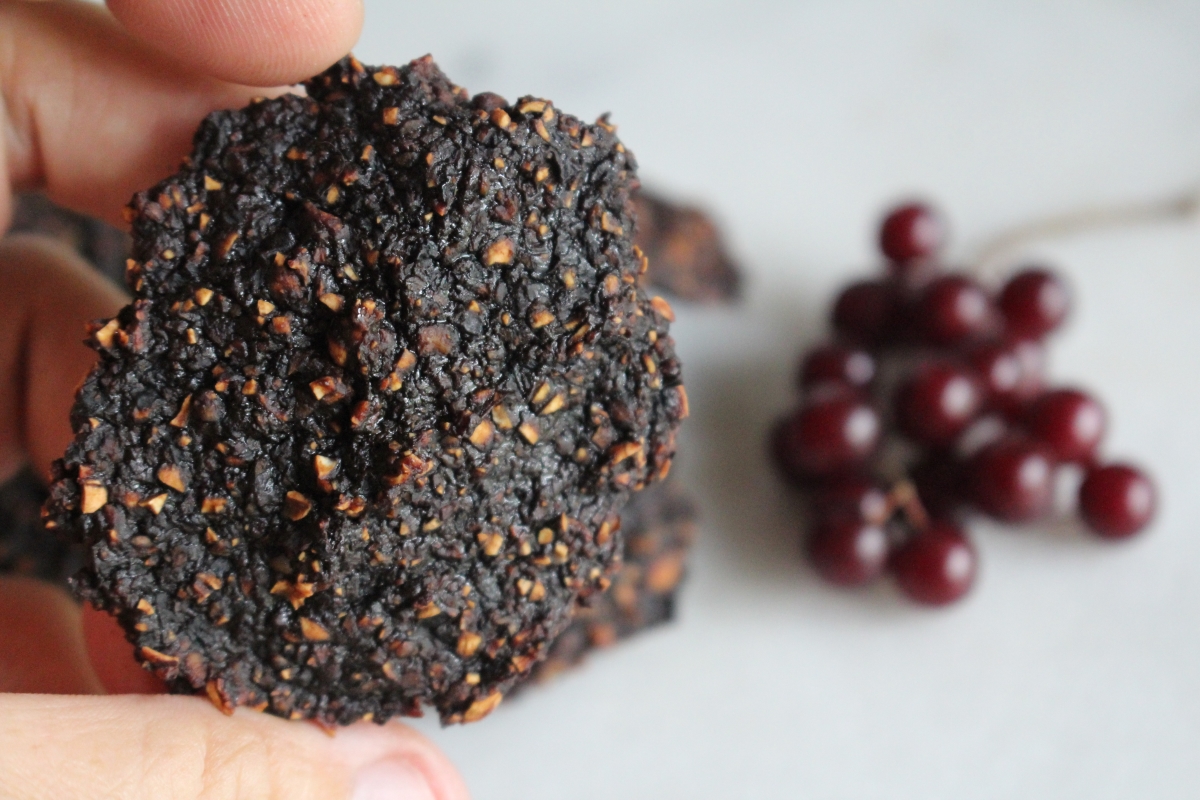
I’m always fascinated by traditional food preservation practices, back before water bath canning and sugar-sweetened jams became the fruit preserve of choice. Sun-drying was used to preserve fruits, greens, and meats all around the world, but some foods are a bit trickier than others.
What about chokecherries, which have large pits and a small amount of fruit flesh?
Chokecherries (Prunus virginiana) are a common wild fruit that’s sweet when dead ripe (though a bit astringent when underripe). They can be harvested by the bucketful in season, and they were an important food source for native peoples.
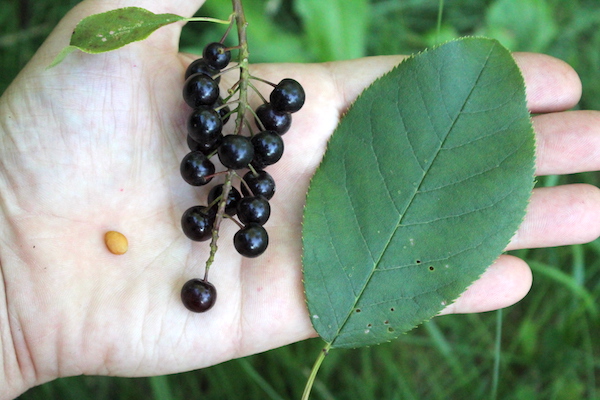
Removing the pits is impractical, and these days most people just make chokecherry jam or jelly by simmering the fruit whole and then straining out the pits.
That method requires large fireproof vessels, like modern stainless steel pots and cookware, and it’s much harder to accomplish with boiling rocks in bark vessels.
It also means throwing away the pits, which are a great source of natural fats and nutrients, similar to nuts.
Native peoples found ways of using chokecherries that used the whole fruit, pits, and all, resulting in more calories and nutrition stored for the colder months, with less effort than modern jams.
Instead of discarding the pits, as we almost always do these days, the chokecherries were pounded whole pits and all. They were then formed into patties or small cakes and dried in the sun. It’s thought that the sun drying denatured the toxins in the pits, and allowed the oil and flavor-rich seeds to be consumed as well.
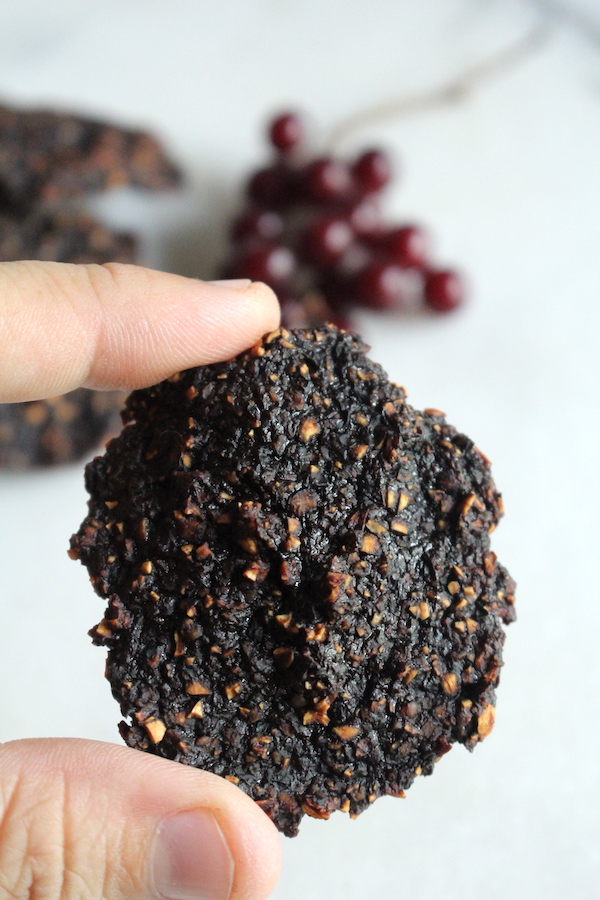
The book Original Local: Indigenous Food, Stories and Recipes from the Upper Midwest has a poem from an Ojibwe woman named Denise Lajimodiere that describes the traditional processing:
“After the first freeze
go out into the Turtle Mountain
bush to your favorite spot
you keep secret from all your cousins
and pick some chokecherries
when they are sweetest,
you won’t have to fight
mosquitos or ticks.
Have your grandkids help you pick.
Pound the chokecherries
on your Kookum’s
flat rock using her oval-shaped
pounding rock that fits snug in your hand.
Grind the pits as finely as you can.
Shape the pounded berries into small
“cookies,” and lay on an old window screen.
Put on top the lean-to where they will dry
slowly in the North Dakota sun.
Store in a cracker tin.
On Thanksgiving day put a couple cookies
worth in a cast iron skillet
with some water and set over a low fire,
when soft and starts to smell like summer,
add sugar and a pinch of flour to thicken,
stir in some bacon grease and fry it up a little,
put a small amount on your relatives’ plates,
kids too, and tell them they have to eat it, pits and all.”
We went through this process, pounding them with a mortar and pestle, and the results were absolutely delicious.
As the pits are split they release an aroma that’s like sweet chocolate and almonds with hints of vanilla, and it’s truly heavenly. I can only imagine what that must have been like centuries ago when those flavors weren’t a part of your everyday pantry.
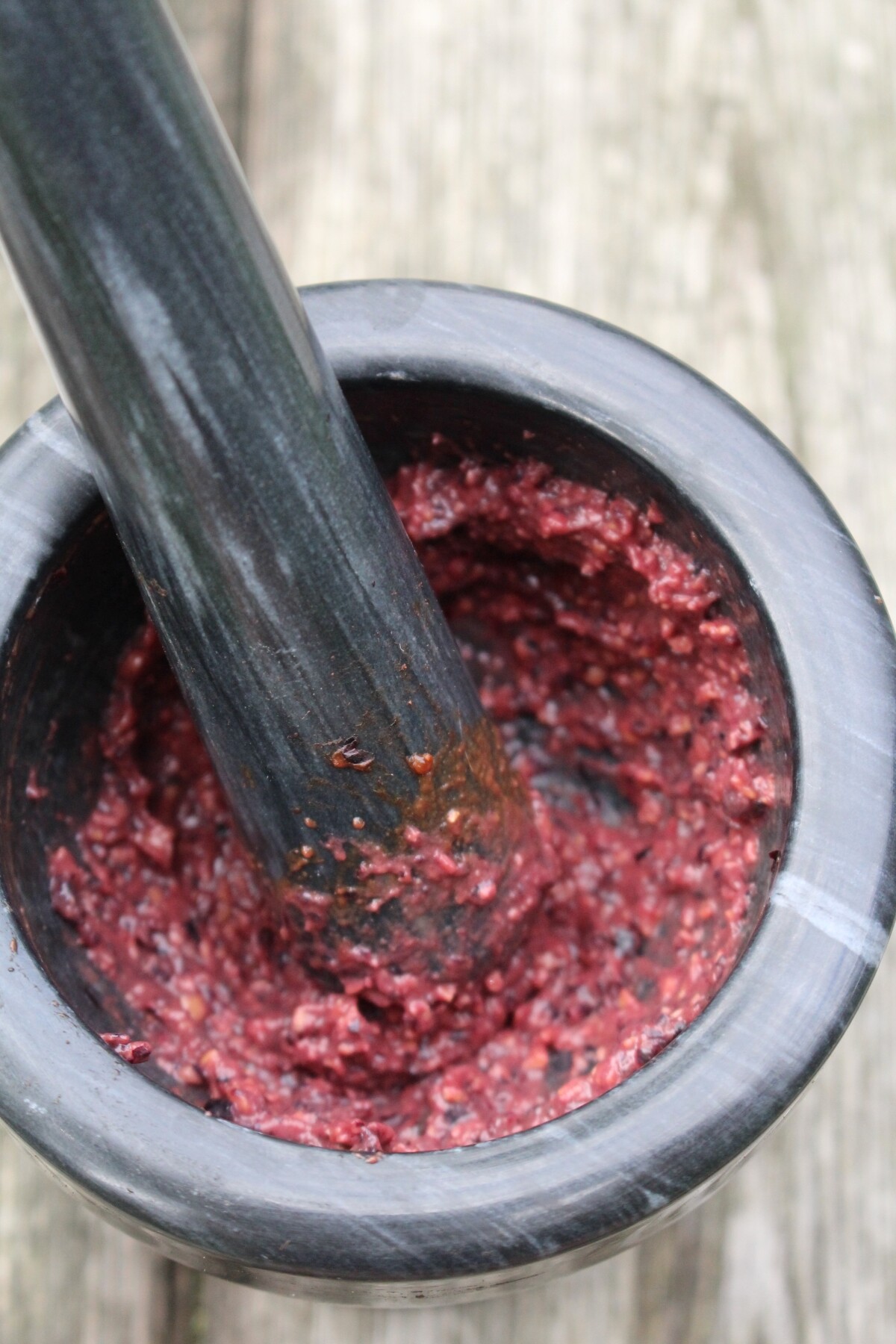
As they dry in the sun, the aromas fill the air and infuse into the whole chokecherry patty. You’re left with something that tastes like dried fruit infused with almond, chocolate, and vanilla.
When picked dead ripe, the chokecherries are quite sweet, and that sweetness is intensified in the drying process. The patties are basically chokecherry candy with nuts from the crushed pits.
The poem above describes cooking them into chokecherry sauce or pudding, which is done in different ways depending on the tribe. It goes by the name wojapi, biinettalappao, tenaaku, and probably other names as well.
Are Chokecherry Pits Toxic?
Now you’re thinking…don’t chokecherry pits have toxins?
Yes, they actually do, just like the pits of other stonefruits like regular cherries, peaches, and plums. Believe it or not, this traditional process denatures the toxins.
According to the South Dakota State University Cooperative Extension Service:
“Chokecherries have a pit in the center that contains a naturally occurring hydrocyanic acid (also called prussic acid, a weak acid smelling of almonds). The process of either boiling or drying will neutralize the acid to make the food safe to eat. Traditionally, chokecherries are preserved by sun-drying. When the drying chokecherries, the whole fruit (pulp, skin, and pit) is ground together. Patties are formed and set to dry in the sun; this process is dependent on consecutive days of hot, windy weather.”
Still, as always, use your best judgment. It’s your health and you’re ultimately responsible for what you put into your body, and food allergies, especially given a completely new food, are always a possibility. If you don’t feel comfortable consuming chokecherry pits, then don’t.
Either way, I’d encourage you to do your own research beyond just taking my word for it. Here’s a few more articles discussing the traditional native American preparations of chokecherries:
- How to Smash Chokecherries (Video Tutorial)
- Native High Plains Pudding with Smashed Chokecherries
- Chokecherries in the Native Diet
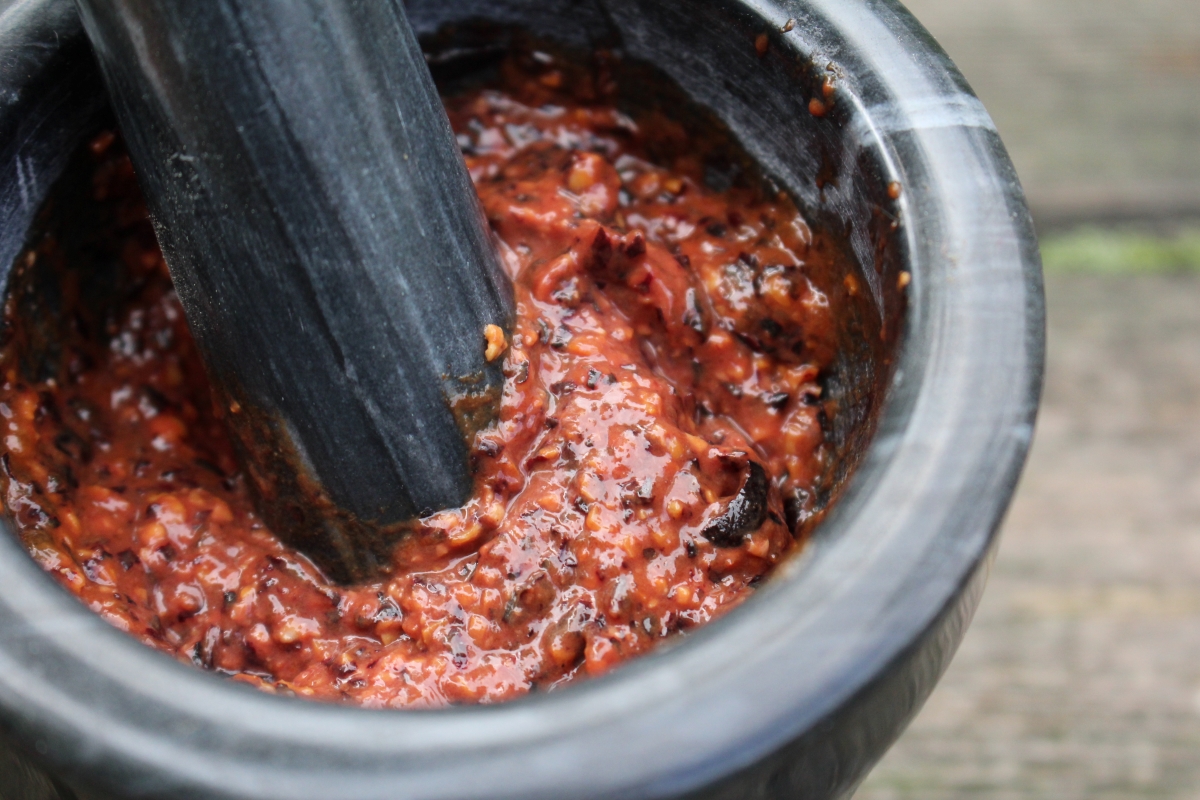
How to Make Chokecherry Patties
For the most part, this hot windy weather tends to happen around chokecherry harvest time in July/August/September, at least across most of the chokecherry plant’s natural range. You can just pound them and then dehydrate the patties on screens in the sun.
That said, the extension service also provides instructions for drying chokecherry patties in a dehydrator. They suggest placing them on parchment or silicone sheets in the dehydrator, then drying for 12 to 16 hours (flipping every 2-3 hours).
You really do need a mortar and pestle for this process, or a rock to smash the pits. Don’t attempt to make this in a food processor or blender. The pits just skip around off the blades and won’t crush. I tried it…and then went back to pounding. Sometimes the old methods really are the best way.
Inside each chokecherry pit there’s a small “nut” and that’s the part that’s rich in fats and nutrition. You can see it if you very carefully crack one with a careful blow from your pestle. As noted above, they contain toxic compounds raw, so you shouldn’t just eat them without cooking or pounding and sun drying.
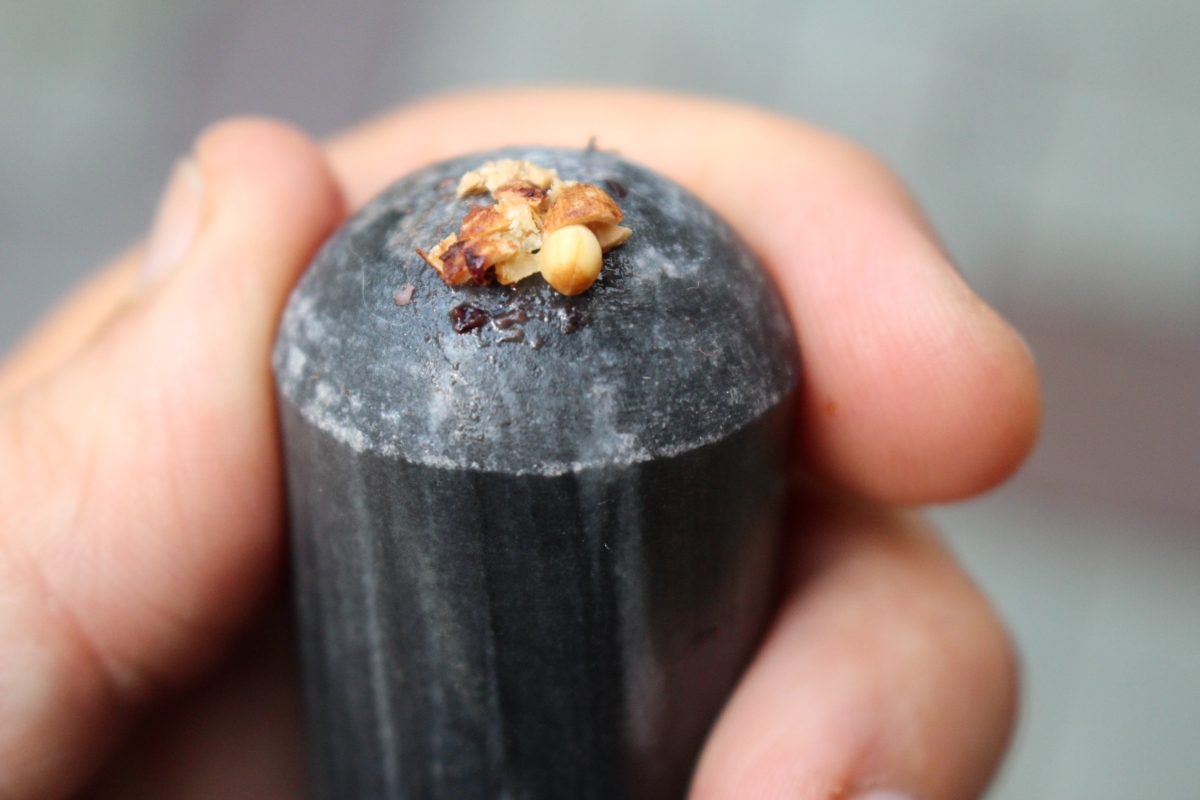
Using Dried Chokecherry Patties
Once you’ve fully dried the chokecherry patties, they should keep for many years (just like any dehydrated food), provided they’re stored well. Keep them in an airtight container and away from humidity, so they don’t reabsorb water from the air.
I have some that I made three years ago and honestly they’re just as good as the day they were preserved.
That said, they would most likely be used over the winter months for fresh fruit flavor in the lean season. I’m sure they made their way into all manner of traditional dishes, but most of those uses are lost to history now. The two that remain are wojapi, which is something like a jam or pudding made from the dried chokecherry cakes, and pemmican.
Wajapi is made differently depending on who you ask, just as any recipe develops alongside family traditions and regional preferences. These days it’s often made just as a simple jam with fresh fruit and maple, skipping the drying process and not even necessarily including chokecherries. Centuries ago, it was a cooked fruit sauce made from dried fruit (like these chokecherry patties), either made plain or thickened with dried cornmeal or acorn meal and enriched with animal fats to make something that’s similar to what Europeans call boiled puddings.
The dried chokecherry patties were also used in pemmican, also called wasna, which is a shelf-stable food made with equal parts dried fruit, dried meat, and tallow. Dried chokecherries add a lot of depth of flavor given they still have the flavorful pits included, and that extra nutrition likely was appreciated.
Properly made and stored, pemmican stores for decades, and was used as a traveling food or cached for leaner times.
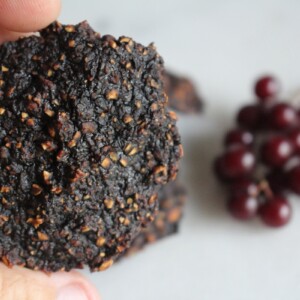
Dried Chokecherry Patties (Native American Recipe)
Equipment
- Mortar and pestle or a suitable pounding stone
- Dehydrator or screens for sun drying
- Parchment Paper if using a dehydrator
Ingredients
- Fresh, ripe chokecherries (with pits)
Instructions
Prepare the Chokecherries
- Harvest Chokecherries: Pick ripe chokecherries when they are fully ripe and sweet, typically in late summer or early fall.
- Pound the Cherries: Using a mortar and pestle, carefully crush the entire chokecherry, pits and all, into a fine pulp. Take care to break open the pits to release the flavors inside, which contribute to the unique taste of the patties.
- Form Patties: Shape the crushed mixture into small round patties, similar to cookies.
Dry the Patties
- Sun Drying: Place the patties on window screens in a warm, sunny spot. Let them dry for several days, ensuring they are exposed to hot, dry winds.
- Dehydrator Option: If you prefer using a dehydrator, lay the patties on parchment or silicone sheets and dry them at 135°F for 12-16 hours. Flip the patties every 2-3 hours for even drying.
- Storage: Once the patties are fully dried, store them in an airtight container in a cool, dry place. Properly dried chokecherry patties can last for many years.
Notes
- Chokecherry pits contain naturally occurring toxins, but the traditional sun-drying process neutralizes them, making the entire fruit, including the pit, safe to consume.
- The dried chokecherry patties are sweet, nutty, and rich in nutrition, making them perfect for winter months when fresh fruit is scarce.
- These patties can be used in traditional dishes like wojapi (a fruit pudding) or incorporated into pemmican, a dried food mixture with meat and fat, perfect for long-term storage.
Nutrition
Nutrition information is automatically calculated, so should only be used as an approximation.
Chokecherry Recipes
Looking for more chokecherry recipes?
Foraged Food Recipes
Incorporate more wild foraged ingredients into your cooking with these recipes:





I have a uterine sarcoma that metastasized to my lungs so I am hoping chokecherry patties and pudding will help kill the cancer.
I am making Wasna, do I need to melt the tallow back to liquid form from a solid, when I add it to the dried crushed chokecherries and chopped bison?
Thanks, and just email me, Scott Bakke
scott.a.bakke@gmail.com
Yes, that’s correct.
I have three gallon bags of frozen chokecherries. I would love to dry them in my dehydrator rather than outside. After reading your article this is what I am understanding…please correct me if I am wrong or have misunderstood something. First of all, nothing was mentioned about using frozen chokecherries, but because the native woman picked after the first freeze, then I am assuming these frozen berries should work okay? They have been washed and stemmed. So it is just a matter of smashing them. After they are smashed they can then be formed into cookies and dehydrated? I know that outside is best, for dehydrating, but it wouldn’t work where we live. Then after the “cookies” are dried I can store them in clean glass jars?
Yes, they are perfectly fine to use after freezing. Actually, it is very common for people to freeze berries first before dehydrating them. They were traditionally dried in the sun but you can use a dehydrator and that will work just fine. The directions for using the dehydrator are in the post if you need them. You can store them in any air tight container once they are fully dried.
Thank you so much for this article. Funny how we have been conditioned to think that pits/stones of the fruit are toxic period! But as I have been learning, it is in the process that it changes.
This year (Summer 2021) have been the most abundant that I have seen the chokecherries in Oregon. There are so many that the trees are bowing and dripping full of these beautiful fruits.
Last year I made juice for syrup and this year I am doing that plus jellies and now I am going to try my hand at these patties. I live in a place where I am very blessed to be able to be able to forage a LOT of foods and herbs where the Natives roamed hundreds of years ago. The elderberries also are very plentiful this year and I really enjoy the syrup from that. I have and am learning so much and going back to food basics.
I just found your site this morning and I am excited to see what else I can find here –
Thank you,
JustARanchWife
Thank you so much for sharing. We are so glad that you are enjoying the site. You are fortunate to have so many wonderful foods to forage.
Oh yes-Indeed very blessed. Thank you for the reply.
God bless. 🙏🏼